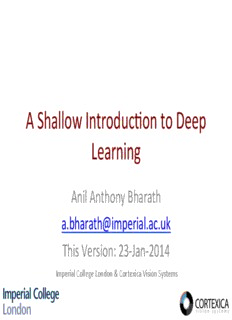
Introduction to Deep Learning - Neural Engineering PDF
Preview Introduction to Deep Learning - Neural Engineering
A Shallow Introduc0on to Deep Learning Anil Anthony Bharath [email protected] This Version: 23-‐Jan-‐2014 Imperial College London & Cortexica Vision Systems Disclaimer • These slides were created with the purpose of explaining biological recep0ve fields and the manner in which similar spa0al paOerns can be “learned” in a DL context. These slides are not intended to be a full review or exposi0on on DL. • These are first-‐genera0on notes; although many elements have been presented previously, the order of presenta0on is new. • I welcome feedback on how this lecture might be improved: I may not agree, but I do not bite. • An accompanying bibliography in DL is available from Woo-‐ Sup Han (BICV Group). Deep Learning: Defini0on • An unambiguous defini0on is debatable, but some characteris0cs are clearly iden0fiable: – A Deep Learning (DL) system contains mul0ple hidden layers of network between input and output layers; – DL systems are reminiscent of mul0-‐layer perceptrons, BUT: • DL systems are oZen trained by exploi0ng both supervised and unsupervised training in the same network; • DL systems may mixed architectures from layer to layer, that oZen conform to hybrid probabilis0c models; • Training regimes may differ depending on layer, reflec0ng a balance between the need to represent and to classify data. Acronyms • DLN: Deep Learning Network • DL: Deep Learning (refers to the field of study) • DBN: Deep Belief Network • DBM: Deep Boltzmann Machine • RBM: Restricted Boltzmann Machine • CNN: Convolu0onal Neural Network • HTM: Hierarchical Temporal Memory OZen not Included • MSC: Map Seeking Circuit Architecture is In DL literature mul0-‐layered, but training is not in the usual manner In order to appreciate DLNs… • We’ll look first at two examples of sensory processing networks; • One is technological, the other is biological; • Both handle visual informa0on. Ramón y Cajal’s Re0na Mammalian re0nal structure – note the apparent layers that are very clearly depicted. Different anatomical Layers are associated with different func’onal proper0es of cells. The layered structure is typical of neural circuitry involved in sensory percep0on. c.1900 By San’ago Ramón y Cajal. c. 1896 The Complexity of Vision Some “sta0s0cs” on the human re0na: – 120 million photoreceptors in each human re0na. – Approximately 5 dis0nct layers of cells. – Various areas of the re0na: • Central Fovea • Fovea • Periphery – Varia0on of proper0es/ra0os of photoreceptors/ganglion cells across the re0na. 7 A “Handle” to Complexity The Recep0ve Field: – A “nearly definable”* concept to describe the effect that a visual s0mulus has on a ganglion cell exhibi0ng centre surround organisa0on. • Change from sustained to transient centre response as s’muli are displaced from centre. • Excitatory responses evoked to opposite s’mulus phase with surround s’mula’on. • Ac’ve inhibi’on of the centre response with surround s’mula’on. • A maximal response can be evoked only with an op’mally sized spot. *The term “nearly definable” is aOributed to Hartline. 8 Recep0ve fields • Spike-‐triggered averaging (STA) – also known as reverse “correla0on”: a probabilis0c characterisa0on of recep0ve fields. • Run through a random series of spa0al paOerns, and empirically es0mate: – P(spike | spa0al paOern s0mulus; t) • Provides a systema0c way of capturing response characteris0cs of cells. The “Op0mal” S0mulus • A visual Interpreta0on of a re0nal recep0ve Field – The “op0mal visual s0muli”: probability of firing of two classes of re0nal ganglion cells might be highest for these s0muli*. – Examples: OFF Centre ON Centre *This is a simplified, but “on average” response. 10
Description: